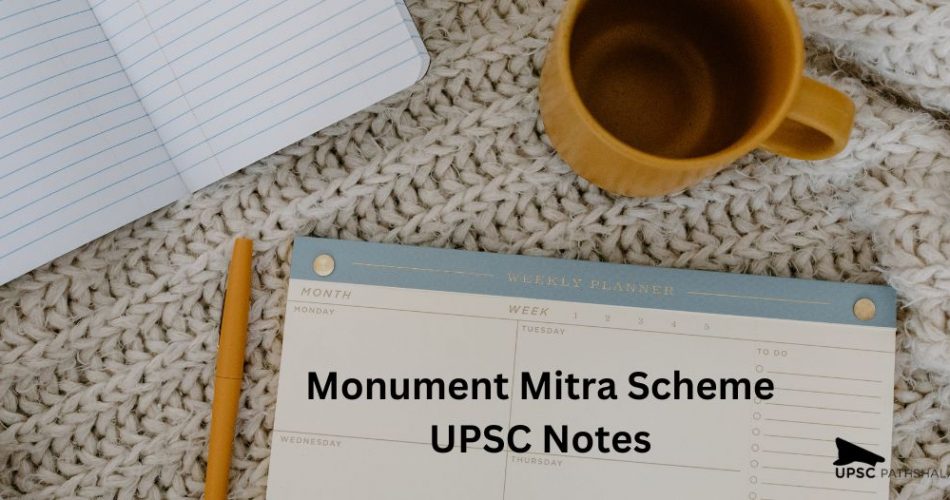The Monument Mitra Scheme is a scheme launched by the Ministry of Culture and Tourism, Government of India. The aim of the scheme is to support and engage private individuals, organizations, and corporate entities in the conservation and development of the country’s rich cultural and architectural heritage. The scheme invites partnership between the public and private sectors for the preservation and promotion of monuments and heritage sites across India.
The scheme is relevant for candidates appearing for UPSC examination, as cultural heritage and its conservation is a topic of importance in the Indian history and culture section of the exam syllabus.
Also Read: Kerala Flood: Important Current Affairs Topic for UPSC Exam !
Facts to know about Monument Mitra Scheme for UPSC Current Affairs
Monument Mitra Scheme is an initiative launched by the government of India to preserve the country’s heritage sites and monuments. Here are some key facts to know about this scheme:
- Objective: The main objective of the Monument Mitra Scheme is to encourage private individuals and organizations to adopt heritage sites and monuments in India and take responsibility for their maintenance and upkeep.
- Implementation: The scheme is being implemented by the Ministry of Culture in partnership with the Archaeological Survey of India (ASI).
- Adoption process: Private individuals and organizations can adopt a heritage site or monument through a formal agreement with the ASI. They are expected to bear the cost of maintenance and conservation work and ensure that the site is accessible to the public.
- Eligible monuments: The scheme covers all centrally protected monuments and archaeological sites that are maintained by the ASI.
- Benefits: Adopting organizations and individuals get recognition for their contribution towards the preservation of India’s heritage, and their names are displayed at the site. They also get the opportunity to participate in various cultural activities organized at the site.
- Criteria for adoption: The organizations and individuals who wish to adopt a monument must have a good track record of social and cultural work, and their financial status should be strong enough to support the maintenance and conservation work.
- Examples: Some of the monuments and heritage sites that have been adopted under the Monument Mitra Scheme include the Red Fort in Delhi, the Qutub Minar in Delhi, and the Hampi World Heritage Site in Karnataka.
- Impact: The Monument Mitra Scheme is expected to help preserve India’s rich cultural heritage and make these sites more accessible to the public. It is also expected to create a sense of pride and ownership among private individuals and organizations towards the country’s heritage.
Also Read Arctic Amplification UPSC: Let’s Get Equipped with the Arctic Amplification Phenomenon!
How to Prepare UPSC Notes on this Scheme?
Preparation of notes on the Monument Mitra Scheme for UPSC is an important part of the overall preparation for the exam. Here are some steps you can follow to prepare comprehensive and effective notes on this scheme:
- Research and gather information: Start by researching the Monument Mitra Scheme and gather information from various sources such as government websites, news articles, and books. Ensure that the information is up-to-date and relevant.
- Organize the information: Once you have gathered enough information, organize it in a systematic manner, making sure to cover all the important aspects of the scheme such as its objective, implementation, eligibility criteria, benefits, and impact.
- Highlight key points: While organizing the information, highlight the key points that you think are important for UPSC and that you need to remember for the exam. This could include statistics, definitions, and examples.
- Use headings and subheadings: Use headings and subheadings to break the information into manageable sections. This makes it easier for you to refer to specific sections of the notes later on.
- Use abbreviations and symbols: To save space and make your notes more compact, use abbreviations and symbols where appropriate. Make sure to define them when you use them for the first time.
- Use diagrams and flowcharts: If you find that a diagram or flowchart would help you to understand the information better, use one. This can also help you to remember the information better.
- Review and revise: Finally, review and revise your notes regularly. This will help you to retain the information and identify any gaps in your understanding that you need to fill.
Remember, the goal is to prepare concise, accurate, and easily understandable notes. By following these steps, you can prepare effective notes on the Monument Mitra Scheme for UPSC that will help you to retain the information and perform well in the exam.
Conclusion
In conclusion, the Monument Mitra Scheme is an important initiative launched by the government of India to preserve the country’s rich cultural heritage. Adoption of heritage sites and monuments by private individuals and organizations is a key aspect of this scheme, as it helps to ensure the maintenance and upkeep of these sites.
Preparation of notes on the Monument Mitra Scheme is an important part of the overall preparation for the UPSC exam. By researching, organizing, and highlighting key points, and using diagrams and flowcharts, you can prepare effective notes that will help you to retain the information and perform well in the exam.
Also Read: Nasha Mukt Bharat Abhiyaan (NMBA): UPSC Current Affairs!







